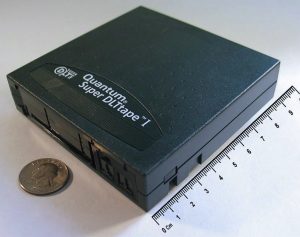History (1997): Tape Storage Thrives in Archival Applications
HP, IBM, and Seagate form Linear Tape-Open (LTO) consortium
This is a Press Release edited by StorageNewsletter.com on May 25, 2018 at 2:15 pmThis article comes from the Computer History Museum.
1997: Tape storage thrives in archival applications
HP, IBM, and Seagate form Linear Tape-Open (LTO) consortium
Quantum Super DTLT 1 tape cartridge

(Jared C. Benedict, Creative Commons BY-SA 2.0)
Despite relatively slow speed of access, data tape in convenient cartridge enclosures continued to evolve as a complement to disks as the lowest cost, lowest power consumption, and most secure technology for storing large amounts of data for long periods of time.
Under contract to Digital Equipment, engineer Fred Hertrick developed the Digital Linear Tape (originally in a 94MB cartridge called CompacTape) format introduced in the TK50 tape drive in 1984. Quantum acquired the tape business in 1994 and offered Super DLT with cartridge capacities of 20GB and above into the early 2000s.
Three leading manufacturers of archival storage tape systems, HP, IBM, and Seagate Tape Technology (also eventually acquired by Quantum), announced the Linear Tape Open (LTO) standard consortium in 1997 to direct development, licensing, and certification of media and manufacturers for new high-capacity tape systems.
Key aspects of the technologies underlying the success of the family of LTO products were prototyped under the leadership of James H. Eaton of IBM.
In 2010, LTO supported the Linear Tape File System (LTFS) format developed by IBM that facilitated tape archive requirements.
In 2015, LTO products are in their sixth generation (LTO-6) and the LTO consortium roadmap has been extended to ten generations.
New generations of tape head technology and media materials, such as advanced lateral head servoing and barium ferrite particle magnetic media, together with perpendicular recording and MR, GMR and TMR film-heads developed for the HDD business, drove an increase in tape storage density, similar to that enjoyed by disks of 30-40% per year.
In 2014 FujiFilm-IBM and Sony independently announced the successful prototyping of new tape materials that will enable recording up to 185TB on one LTO-6 format data cartridge.
The technology continues to advance: in early 2015 Fujifilm and IBM reported achieving a tape cartridge uncompressed capacity of 220TB, which represents the highest storage capacity ever for any unit of storage media.
Studies by independent industry analysts continue to indicate that tape provides the lowest TCO of any technology for long-term archival information storage.













 Subscribe to our free daily newsletter
Subscribe to our free daily newsletter

